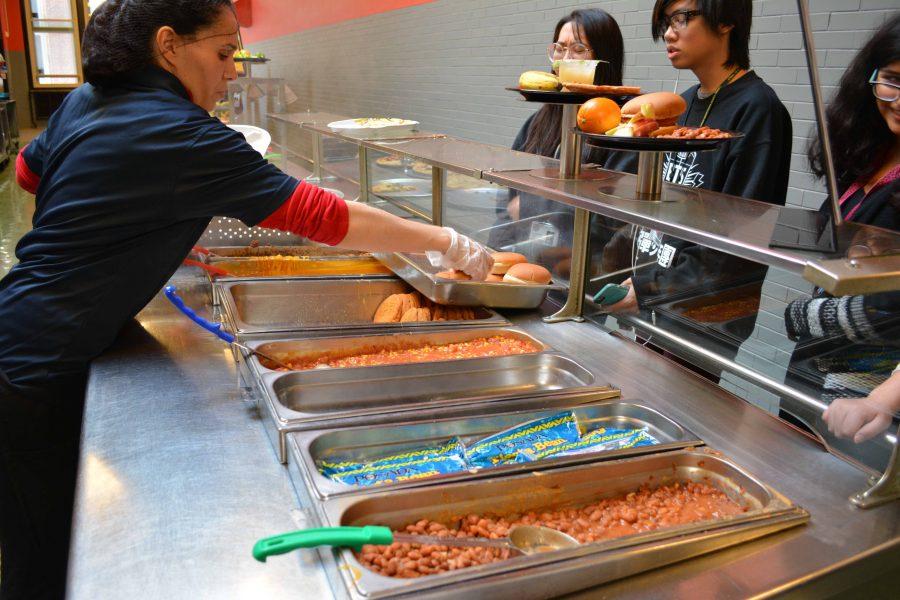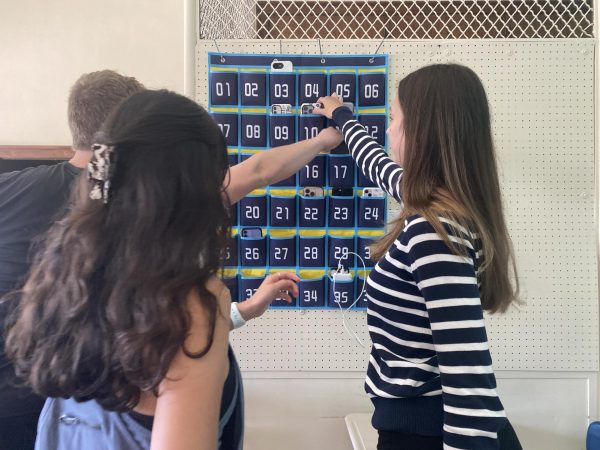Got lunch?
A cafeteria worker serves some of the 43 million lunch meals served by CPS each day.
Every day, hundreds of Lane students walk in and out of the school lunchroom, consuming the school breakfasts and lunches. The real mystery to most students at Lane is where this food comes from. According to the Chicago Public Schools (CPS) budget, they serve approximately 26 million breakfast and 43 million lunch meals, making it more important than ever that these meals are healthy and beneficial to the students ingesting them.
In recent years, new regulations have been put in place to improve children’s health. The Healthy, Hunger-Free Kids Act (HHFKA) passed in 2010 by former President Barack Obama has changed the standards of school meals throughout the country. HHFKA set new nutrition standards for schools and designated $4.5 billion for their application.
According to the CPS website, these regulations offer students fruits, vegetables, whole grains and low fat milk. CPS also limits calories based on the age of children being served. This is done to “ensure proper portion size; and reduce the amounts of saturated fat, trans fats and sodium,” according to the CPS website.
Although these standards have been set to increase the nutrition of the lunches, many students end up throwing the fruits and vegetables the school provides in the garbage. Salma Jaimes, Div. 056, is a regular consumer of the school lunches and said she sees this happen quite often.
“I know we have the choice to pick things, but I don’t think students want to pick the healthy things because they don’t taste as good,” Jaimes said. “Because I come here and I’m hungry, I’ll eat anything, but if I had a choice to pick my own lunch, I wouldn’t eat the school lunches.”
Jaimes, along with many other Lane students, enjoys the school’s pizza the most. “It’s simple, and the best thing there,” she said.
Registered nurse Lisa Verdon has experience with Lane’s school lunches because of her daughter who started at Lane last year. Verdon examined the nutritional information of the school’s popular pizza.
“It’s not very clean, there’s a lot of stuff I can’t even pronounce,” she said. “Overall, it doesn’t look like it would be that bad. I probably wouldn’t eat more than one, but for food service and trying to serve a mass amount of children it looks pretty healthy.”
Since CPS serves so many students meals each day, they need to make meals functional and affordable. According to the CPS budget, the proposed budget for school nutrition services in 2016 was $230,760,253. This money is used to buy the food and the materials needed to serve the food, as well as the salaries of the lunch staff.
“If you do have something like this every day, it’s fine, but round it out to make it more whole. If kids don’t have that option of having a homemade meal, or if this is their only meal for the day until they get home, totally eat it, but also make sure to add in your fruits, vegetables, milk, and make sure you’re getting enough water,” Verdon said.
CPS’ meals are provided by the food distribution company Aramark. According to Aramark’s website, in creation of the meals, they use “science-based frameworks outlined in the Dietary Guidelines for Americans and MyPlate” to develop their menus.
Allison Polke, a registered dietitian for CPS said that the only raw meat product on the menus is the chicken drumstick, which the dining staff cooks at 155 degrees to make sure they are safe to eat.
“All the other products come in ready prepared. They are frozen and warmed,” Polke said.
Polke also described the steps CPS is taking to decrease school waste and give back to the community.
“We have a program called Food Share,” she said. “It’s implemented in the school and the dining staff works with an outside organization, whether it’s a food pantry, shelter or church, they will come and pick up the food from a place in the lunchrooms.”
“Staff can collect whole fruit and produce, and packaged items like the benefit bars students get in the morning for breakfast, cereal bowls, crackers, things along those lines.”
According to the CPS website, throughout the school year of 2014-2015, more than 9,000 pounds of produce were donated. These donations provide healthy food for the homeless and poor of Chicago.
“As far as the already made foods such as pizza, we have to throw away whatever is leftover,” Polke said. “We’re not able to donate it. Thats a food safety regulation and a liability, so the USDA doesn’t allow that.”
Gabriela Gonzalez, Lane’s dining manager says Lane does not take part in the Food Share program.
“It would be nice because maybe if you don’t want the orange, you put the orange back, but maybe some other kid wants it, they can share between the students,” Gonzalez thinks a system like this could be implemented at Lane, but it would take a lot of work from staff members.
“It seems simple, but it’s not. It needs to be very organized,” Gonzalez says.
Verdon urges children to think about what they’re eating, and the importance it has on their success in school.
“With growing bodies, hormones, and bone maturity, teenagers need a lot of food at this point,” Verdon said. “You need to feed your brain and your body.”
Your donations directly fund the Lane Tech student journalism program—covering essential costs like website hosting and technology not supported by our school or district. Your generosity empowers our student reporters to investigate, write, and publish impactful stories that matter to our school community.
This website is more than a publishing platform—it's an archive, a research tool, and a source of truth. Every dollar helps us preserve and grow this resource so future students can learn from and build on the work being done today.
Thank you for supporting the next generation of journalists at Lane Tech College Prep!

Simone Brenner is an A&E Editor for the Warrior. She is passionate about writing and learning new things about the people at Lane and events going...




